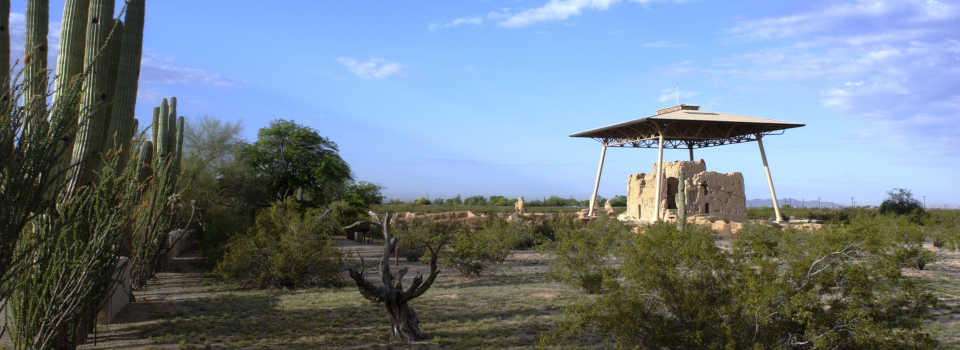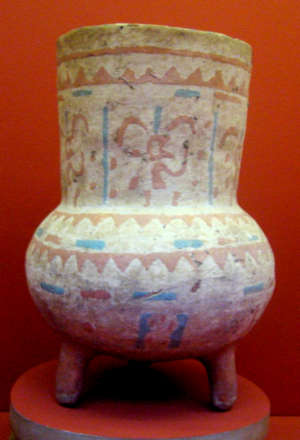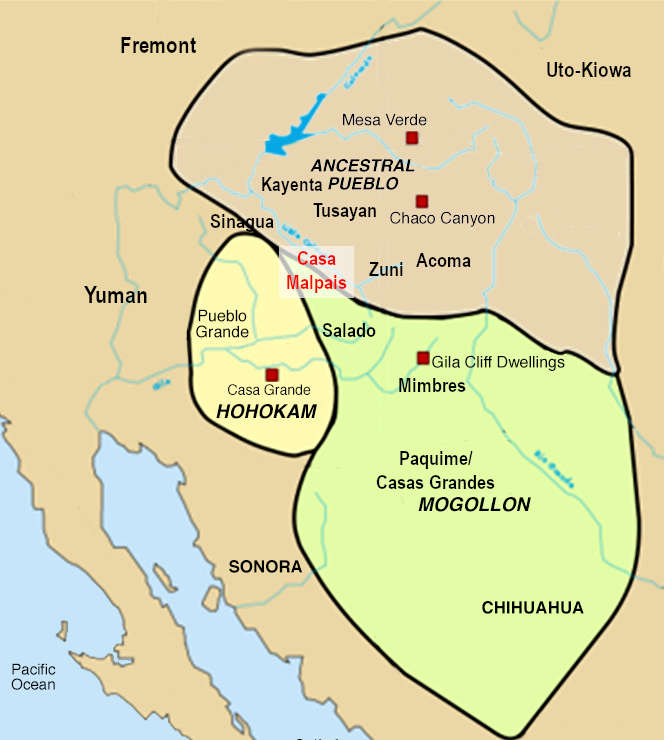Hohokam Culture

The Casa Grande Ruins

A Hohokam pot from Casa Grande
The people of Caral, in the desert of northern Peru, were building monumental irrigation systems more than 5,000 years ago. Similar irrigation systems were being deployed along the Santa Cruz River in the Tucson Basin of Arizona beginning about 4,000 years ago. As their population grew, the population systematically moved downstream along the river as they built new irrigation structures and canals. Eventually they reached the Gila and Salt Rivers.
These were not the people we know as "Hohokam," they were predecessors of the Hohokam. A distinct Hohokam culture seems to have emerged after 300 CE. Incoming migration came to a head, migrants coming with their own ideologies, hierarchies and technologies. Through those hierarchies they organized and instructed the local people in how to survive a calamity, like the sun going away for years. Some of those indigenous people were fine with how that worked but others weren't. Over the years of Hohokam ascendancy, the more fundamentalist indigenous people tended to migrate upstream along the rivers and into the canyons along the Mogollon Rim. The Valley of the Sun was taken over by the Hohokam Core.
Another incoming migration of people from the south has been recorded in the mid 500s. A volcano in Indonesia erupted in 535 and filled the global skies with ash. The results of that caused one historian to call 536 CE "the worst year to be alive" as the effects were felt world-wide for several years. Then came more drought. People moved, looking for a better place to live.
The newcomers brought new technology, new trade connections and refinements of the common Flower World ideology. They also brought cotton and new methods of weaving textiles from it. The center of their culture formed first at Snaketown. Snaketown grew for several hundred years, reaching its peak in the early 1000s. The population rose as people continued building their irrigation networks and spread through other river valleys that fed into the Gila-Salt River system. Then began the volcanic eruptions that caused global ash-filled skies in the early 1100s. This caused an immediate retraction of Hohokam colonists to the Core area, and a reorganization of their society at all levels. This happened a couple more times, too, before the Salado ideology and culture arose in the upper Salt River Valley around 1250 CE. At its height, Snaketown may have housed several thousand people. By about 1150 Snaketown had been abandoned and burned. The center of Hohokam culture moved downstream to the vicinity of Pueblo Grande where it remained until finally dissolving into the volcanic ash-filled desert air around 1450 CE.
The people we call "Hohokam" occupied the greater part of central and southern Arizona for more than a thousand years. They have been primarily noted for their development of irrigation and their construction of elaborate water control and distribution systems. But like the Ancestral Puebloans to their north, their landscape and culture went through several phases over the years, beginning with nomadic hunter-gatherers and itinerant traders and proceeding through the development of pithouses, above-ground dwellings and finally multi-story pueblos. However, by the mid-1400s CE a great drought set in all across the southwest and the centers of Hohokam culture disappeared as the people migrated to areas with more water and less heat.
Major Hohokam centers that have been identified are Snaketown, Casa Grande and Pueblo Grande. Snaketown was abandoned and burned around 1050 CE and most of those people moved to the area of Pueblo Grande. Pueblo Grande was built around the confluence of the Gila and Snake Rivers in what is now the Phoenix basin (the Valley of the Sun).
Evidence of a culture from which the Hohokam may have evolved has been found in the Tucson basin. That evidence indicates a culture that began more than 3,000 years ago but most archaeologists are agreed that the major defining facets of Hohokam culture emerged around 300 CE. Their pueblos were located at the crossroads of major trade routes connecting the Mogollon to the east with the Pitayan and the Pacific coast to the west, the Trincheras in Mexico to the south with the Ancestral Puebloans to the north and east.
With influences from their trading partners showing everywhere, it is thought there was a lot of immigration and trade to and through the Hohokam centers.
By 1300 CE, Pueblo Grande was probably the most populous city in the Southwest. By 1460, the sky had been ash-grey for several years, another Great Drought was happening and everything in the Hohokam Core area was abandoned.
Archaeologists think that most of the people migrated to cooler, wetter areas in the surrounding mountains and are the ancestors of todays Tohono O'odham and Pima peoples. Some may have gone east into the Salado area but the Salado people also disappeared around 1450.
When the Apache first came into the area around 1500 CE, there was virtually no one to oppose them until the Spanish came along in the 1530s.
Some irrigation systems built by the Hohokam are still visible from space. Some sections of those systems have been dug out and are still in use in local irrigation systems.
The Hohokam Chronological Sequence
- The Pioneer Formative Period : 1-750 CE
The early Hohokam have been traced to a group of small villages in the middle Gila River basin. Their culture was successful enough that they grew to develop trade routes with northern Mexico. It was around 300 CE when new squash, beans, cotton and other seeds began to appear, probably brought north through trade with central Mexico. Cultivating these crops required the development of irrigation systems and once there was that kind of investment in a physical plant, the people became quite sedentary. Population growth was limited only by the ability of their systems to feed their people. - Colonial/Pre-Classic Period : 750-1050 CE
Throughout the period villages grew larger and irrigation systems expanded and grew more complex. Social stratification began and burial ceremonies grew more complex. The culture grew more prosperous as attested by the evolution of pottery with a red slip over a buff paste. Influences from Mexico increased and marketplaces were built in many areas. Common courtyards and common-use ovens developed. The largest settlement of the time, Snaketown, was partially burned, then suddenly abandoned in 1050. - Classic Period : 1050-1450 CE The Classic Period saw larger and larger residential complexes and irrigation systems built in the Gila-Salt River Basin, in the Tucson Basin and in the area around Grewe-Casa Grande. The end of the period began with a massive volcanic eruption on the other side of the globe. The sky turned ash-grey for several years. Colder temperatures with floods and widespread famine ensued. The social stratification of Hohokam society collapsed almost overnight and the people began to stream out of the area headed mostly east or south. By 1460 what was once the most densely populated region in the American Southwest was almost entirely depopulated.

Montezuma's Castle

The Mesa Grande ruin in Mesa, Arizona
Pottery photo courtesy of Flickr userid Beesnest MaClain, CCA 2.5 Generic License
Photo of Hohokam Sacaton plate courtesy of Peter Tillman, CCA-by-SA 2.0 License
Lower photo courtesy of Tomas Castelazo, CCA-ShareAlike 3.0 License
Bottom photo courtesy of Wikipedia userid Tony the Marine, CCA-ShareAlike 3.0 License

